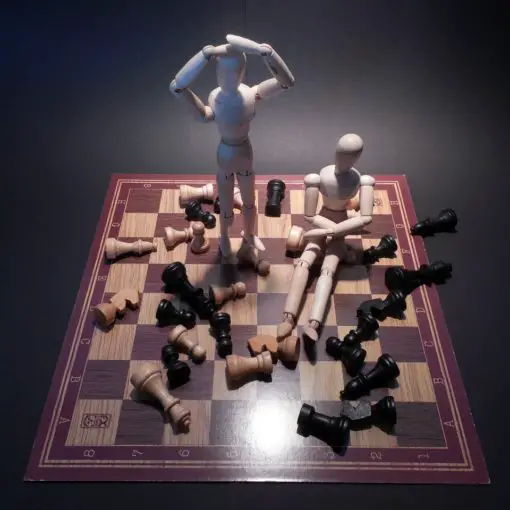Critical thinking is a valuable life skill that helps solve problems at school, in the workplace or in everyday living. Riddles can be a fun way to test, practice and develop your critical thinking skills. Our 5 critical thinking riddles will help you develop your brain power and have fun.
Read what we have to say about critical thinking and riddles below, perhaps look at our simple hints and tips for beginners, and then test your skills with our five simple but stretching critical thinking riddles.
Don’t worry if you don’t get the riddles immediately. We’ve also provided full answers and explanations which should guide you in learning how to think critically and help you to solve future riddles and problems.
Enjoy!
Why is critical thinking important?
Life can be complicated and difficult. There is often so much information available, so many options and approaches to choose from, and a host of competing priorities driving us simultaneously in different directions.
How do we know which information is relevant? Which option is most sensible? Or which priority is really most important? Working out the best solution to a problem can feel like a real challenge!
The answer lies in critical thinking. Critical thinking skills can help you to cut through the confusion, organizing and structuring your thought processes and guiding your analysis through to a sound conclusion.
From Socrates to Einstein, and into the present day, some of the wisest minds have been advocates of critical thinking and we agree with them. Practicing critical thinking promotes curiosity, creativity, intellectual independence, and all-round problem-solving ability.
How can I learn critical thinking skills?
Critical thinking includes a number of different skills and their synthesis. It is impossible to exhaustive in setting these out but generally critical thinking can be taken to include competence around:
- Analysis. Understanding and grasping the problem or question; distinguishing relevant from irrelevant information; identifying connections, commonalities and differences; and, producing analogies.
- Inference. Using inductive or deductive reasoning to draw out meanings; identifying assumptions; abstracting ideas; applying analogies and recognizing cause and effect relationships in order to develop theories or potential conclusions.
- Evaluation. Assessing the strength, value, or credibility of a theory; modifying ideas in reaction to counterarguments or new data; understanding the significance of information.
- Decision-making. Applying the thinking processes above in order to reach conclusions.
In addition to developing the ability to think critically, you must also possess an attitude that inclines you to apply critical thinking when you encounter a problem or puzzle. Dispositions relevant to critical thinking include fairness, open-mindedness, a desire to be well-informed, and the willingness to consider other viewpoints.
As you can see, learning critical thinking is not something that can be quickly picked up by reading a book or listening to a lecture. To develop critical thinking skills, you must practice critical thinking. One of the most fun ways you can do this is through riddles, such as our 5 critical thinking riddles in this article.
Riddles for Smart People: 100+ Original Puzzles to Solve with Friends (Books for Smart People)
These 100+ riddles are designed to:
- Foster creative thinking
- Encourage critical self-reflection
- Enhance problem-solving abilities
- Broaden your vocabulary
What are riddles?
Riddles are puzzles framed as phrases, statements, questions or short poems. They may use any combination of double-meanings, implicit ideas and logical deduction to set up a thought-provoking challenge for the solver.
We can loosely divide riddles into two main types. Firstly, enigmas, where puzzles are expressed in allegorical or metaphorical terms, requiring the solver to think carefully and creatively in order to reach the solution.
Secondly, conundrums, where puzzles rely on wordplay, especially puns, in either the question or the answer. The solver must pay close attention to wording as much as content in order to solve the puzzle.
Riddles appear to be a universal form of human puzzle, appearing across hundreds of different cultures and languages and existing for thousands of years. Some riddle-themes or specific riddles with wide human relevance appear in multiple countries and times. For example:
Riddle: What has four feet in the morning, two feet at noon, and three feet in the evening?
Answer: a human being.
Explanation: A baby in the morning of life crawls on four feet. An adult in the noon of life walks on two. A senior, in the evening of life, walks with a cane, giving them three feet.
This famous “Riddle of the Sphinx” came originally from ancient Greece but is also found in locations from Estonia to the Marshall Islands.
Unlike more academic textbook problems, riddles are also traditionally intended to be fun, and to be accessible to all. You do not need to be any particular age and should need no special equipment or expert knowledge to tackle riddles. You need only a sharp mind and the ability and will to use it!
Now, let’s take a look at our set of five critical thinking riddles…
1. Family tree riddle
If A is the sister of B, B is the sister of C, and C is the mother of D, then what relation is D to A?
Answer
D is A’s niece / A is D’s aunt.
Explanation
Riddles often contain some form of misdirection to try and send your train of thought off in the wrong direction (or in multiple directions). They might also imply something which puts your mind unnecessarily into overdrive on complicated ideas so that you miss the simplest explanations.
This particular riddle uses letters instead of names when talking about family members, which may put the solver in mind of mathematics or logic puzzles. This may then cause a set of quite straightforward relationships to seem far more complicated than they actually are.
If reading this type of riddle immediately confuses you, then try assigning names to each letter instead, and/or draw a mini family tree to help you follow through the relationship logically.
2. Riddle at the crossroads
Four cars reach a four-way intersection at the same time, one coming from the north, one from the south, one from the east and one from the west. All are travelling at the same speed and arrive at the stop sign simultaneously so that priority is unclear. All decide to move at the same moment.
Although all four continue driving, none of the cars crash into one another. How is this possible?
Answer
All four cars made right hand turns at the same time.
Explanation
In contrast to the previous family tree riddle, this intersection riddle tries to misdirect your mind into thinking too simply. It draws up an image in your mind of four cars all facing one another and driving forwards in a straight line, making a crash apparently inevitable.
However, cars obviously do not only move in straight lines at four-way stops. They may also turn and if all four cars are executing a right hand turn at the same moment, then they would avoid any crash.
3. A riddle in time
What occurs twice in every moment, once in every minute, but also never, ever in a hundred thousand years?
Answer
The letter “M.”
Explanation
This riddle misdirects your mind into thinking about time and events as concepts when the actual answer lies in the far simpler and more accessible field of the alphabet! It is an example of a whole class of riddles which are cleverly written but simple letter or word puzzles.
4. Deadly elevator riddle
In a large department store, an empty elevator begins its journey on the ground floor. At the ground floor, four people get in, including me. At the first floor, one person gets out and five more people get in. At the second floor no one gets out and ten more people get in.
As the elevator rises towards the third floor, its cable snaps and it falls down the shaft, crashing to the floor at the bottom. Everyone dies in the elevator, but I am alive. How did I survive?
Answer
I was the one person to leave the elevator at the first floor. I was therefore not in the lift when it crashed and I “survived”.
Explanation
This time the riddle both attempts to bamboozle you with an overload of information and misdirects you further at the end with a question that invites more complex speculation about how to survive an elevator crash.
Most of the information about how many people got in and out at each floor is irrelevant. The answer to the riddle does not lie in devising interesting methods and positions for surviving lift crashes.
The answer actually lies in thinking simply and logically about the facts as stated. We are told that one person got out of the elevator at the first floor. The most logical explanation for my ‘surviving’ the deadly elevator crash, is that I was that one person.
5. Bear color riddle
I am on an expedition far from civilization. This morning I left the campsite and walked south for 1 mile. Changing my mind, I turned east and walked for 1 mile, before turning north and walking for 1 mile. At this point I ended right back where I started… A bear was inside my tent, eating my food supplies. I shot it. What color was the bear?
Answer
White.
Explanation
Sometimes riddles are not purely logic-based but also rely on the solver knowing or being able to deduce a fundamental piece of general knowledge.
To solve the riddle in this case, you need to know that the North Pole is the only place on earth where you can walk 1 mile south, east, and then north, to turn up back at the same place. You also need to know that polar bears are the only kind of bears living at the North Pole and that polar bears are always white.
Without knowing these things, and putting the pieces together, you would not be able to solve the riddle. This is all part of the broader picture of critical thinking.
Riddles for Smart People: 100+ Original Puzzles to Solve with Friends (Books for Smart People)
These 100+ riddles are designed to:
- Foster creative thinking
- Encourage critical self-reflection
- Enhance problem-solving abilities
- Broaden your vocabulary
Simple hints and tips for solving critical thinking riddles
Beginners may want to think about these simple hints and tips right at the start when approaching a problem for the first time. Or, you may prefer to come back and refer to them later after trying our critical thinking riddles or similar puzzles.
Focus on the wording. Are there multiple meanings for key words? Are the component letters in the words important in some way, as they were in our time riddle? Why might the riddle be worded or framed in a particular way?
Analyse and evaluate the clues given very carefully. One small piece of information could hold the key to solving the complete riddle, while several larger pieces might only be included to distract or misdirect. Think about the elevator riddle and its various clues about how many people got in and out at each floor.
Map out your thinking. Writing down some notes or drawing a diagram can often help to clarify and structure your thoughts. It might also demonstrate that the problem is not as complex as the wording of the riddle suggests. This could be a helpful approach in our family tree riddle.
Identify your own assumptions and preconceptions. It’s impossible to avoid making assumptions entirely but do be wary. Try to be notice when you are making assumptions and question whether your assumptions are reasonable. For example, in the puzzle of the four cars at the intersection, are you automatically assuming that the cars will proceed in a straight line? If so, is this reasonable?
Think far outside your box. For our bear riddle, some of the earlier hints and tips might prove unhelpful if you don’t also think creatively. A diagram of the walking route could make you think: “That’s impossible!”. But it would be useful if it prompted you to ask: “Where is the only place on earth where I could walk in this pattern and end up at the start…?”
A final word…
We hope you have enjoyed our 5 critical thinking riddles. If you have, or you’d like to learn more, why not buy yourself a puzzle book, search out some more critical thinking riddles online or even make up your own…






